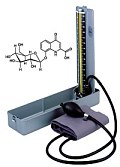
A new approach to testing urine samples without having to purify them first has led to the discovery of a new hormone that controls sodium excretion and so could be involved in controlling high blood pressure. Too much sodium equates to raised bp. The discovery solves a riddle that confronted medical scientists for more than four decades and could lead to new approaches to treating high blood pressure.
I asked team leader Frank Schroeder about the work and discuss it in detail in this week’s SpectroscopyNOW. One issue that must be addressed before such a discovery can be applied realistically to the develop of new therapies for high blood pressure, or even low blood pressure, is to find out whether the hormone is involved in other control systems in the body. This is somewhat likely given that most other known hormones multitask. I asked Schroeder about this aspect of the research:
“At this point, it is difficult to speculate about what other biological processes might be influenced by the newly identified compounds, and the next step will be to find the receptor(s) that the [hormonal] xanthurenic acid derivatives bind to,” he told me. “From our analyses, it appears that the two xanthurenic acid derivatives represent the actual signalling molecules – the activity is very well-defined and the compounds are of high specific potency. Furthermore, a closely related metabolite, xanthurenic acid itself, is not active.”
Also, in this week’s issue, in the field of atomic spectroscopy, Jordanian scientists have found that garlic extract can reduce the levels of the toxic heavy metals, cadmium and lead, in vital organs, such as the liver, heart, and kidneys. You can read more about that here.
In pure chemistry, it has been a record-breaking year for coordination chemists Klaus Theopold and Kevin Kreisel of the University of Delaware and their colleagues who have synthesised an organometallic chromium compound with the shortest Cr-Cr bond ever. Not since the 1978 work of F. Albert Cotton and his team at Texas A&M University has such a short one been seen. Theopold told me that he does not think it will be too long before this new record is broken. “I don’t think it will be another 30 years, although I’d like to hold on to the record for a while,” he said, “As to who, there are three possibilities: somebody who is not trying for it, and discovers it accidentally (like us), Phil Power, or myself, because I am now interested and have some ideas.”
Finally, the rather delicate subject of turning raw sewage into compost for farms. Remy Albrecht of the Paul Cézanne University in Aix-Marseille and colleagues have developed an infra-red technique that could be used to monitor how well the composting process is going for biological wastes, such as sewage sludge. Obviously, compost quality for land application must be monitored and controlled closely, but there are so many benefits, such as quickly raising nutrient levels and improving soil quality that it is worth the effort. An analytical approach to near infrared reflectance spectroscopy can provide an inexpensive way to monitor the composting process, Albrecht told me.
“NIRS is a highly reproducible technique able to draw a precise chemical fingerprint of an organic material Moreover, NIRS is rapid and makes it possible to analyse a large number of samples in a practical and timely manner. Control of maturation can be easily simplified with good calibrations and a data bank in reference,” he said.
I do worry about the accumulation of heavy metals from such biological sources as with each iteration from crop/livestock, to dinner table, to sewage plant, back to farm, they could increase in concentration. There is also the issue of pathogens. I’d be interested to learn what safeguards are in place to prevent their circulation.